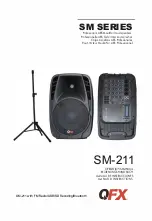
Preliminary Recommendation
A word of warning on high sound levels - these speakers are capable of generating high output levels over sustained
periods of time and such levels, over 95dBspl for 8 hours per day, can eventually cause permanent hearing loss. Since
Tannoy monitors have a natural-sounding flat frequency response and low distortion, it's possible not to be aware just how
high the sound level is high while working with them.
For continuous exposure we recommend the occasional use of a sound level meter. This should be capable of integrating
the sound level over a period of exposure according to noise control standards and used just to check that noise levels
are always within safety limits. It is usually accepted that 80dBspl is a safe level for continuous exposure.
Speaker Placement
Speaker placement, and the listening environment itself, can completely compromise the performance of any loudspeaker.
It is important to understand some of the positional limitations of near-field speakers, and the operating environment, in
order for you to gain maximum performance.
Your Ellipse iDP
™
monitors have an integral rubber base that will allow non-slip, vibration free mounting on the near-
field platform on your desk or a dedicated speaker stand. Alternatively the rubber base may be removed and an "Omnimount"
wall bracket attached, increasing the range of mounting and location possibilities. The construction of the Ellipse incorporates
magnetic shielding for the drive units. These monitors can therefore be used in close proximity to TV screens without any
picture distortion. The greatest stray magnetic field is radiated from the front of the main driver, but it's unlikely you'd put
your VDU right in front of the speaker. Side-by-side placement should be OK virtually touching, and, of course, modern
non-CRT flat screens are unaffected by magnetic field.
Orientation
Where do you aim the speakers to give you the smoothest and most consistent sound?
How far apart do you place them to give you a good stereo image?
For a stereo set-up the basic rule is to arrange an equilateral triangle. The distance between the two monitors should be
roughly the same as the distance between one monitor and your ears, this in the listening position where you are leaning
forward on the console armrest.
This distance translates into a usual listening distance, for a near-field system, of around 1.3m (4'3") from each speaker,
implying that the speakers will be around 1.3m (4'3") apart to create the normal equilateral arrangement applied in most
stereo set-ups.
The speaker horizontal axis should be aimed at a point halfway between the two extremes of the listening positions (furthest
forward and back) used when working. This is typically a range of about 600mm (24"). If possible, line up the vertical axis
on a level with your ears referencing to the very centre of the Dual Concentric
™
drive unit.
You can now confirm that you are on axis in both planes. First ensure that your head is in your normal listening position,
look into the centre of the Dual Concentric
™
high frequency unit wave guide, if you can see the gold colour of the HF driver
dome in the centre of the WaveGuide
™
, then you are close to the ideal listening position. Also, having the monitors angled
in towards the user minimises high frequency reflections from walls and outboard gear. Keeping close to this height, while
moving around horizontally to access extremes of the desk and so on, will maintain a consistent frequency response;
experienced as a wide "sweet spot" in which to work. For surround set-ups refer to specific ITU 775 or AES guidelines.
10
Summary of Contents for Ellipse 8 iDP
Page 1: ...Owners Manual TM ...
Page 2: ......
Page 48: ...48 Dimensions Ellipse TS212 iDP Grey Silver 520mm 20 47 490mm 19 29 498mm 19 6 ...
Page 55: ......











































